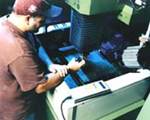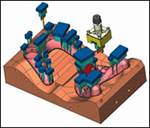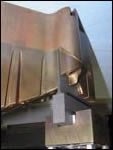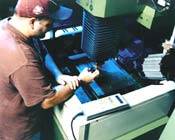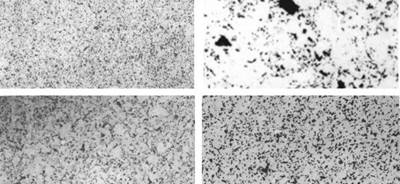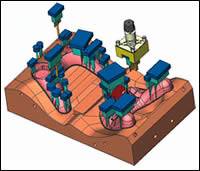A Double Whammy
The solution to solving problems associated with EDMing high copper alloy work metal involves finding the right graphite electrodes.
Chris Double, die sink EDM manager of Concept Molds (Schoolcraft, MI), faced a double whammy: a tight production schedule and an unfamiliar set of technical challenges. The project involved creating a mold for an accelerator pedal bracket, which required large ampcoloy inserts to produce the strengthening ribs.
Although he handles a variety of customized jobs, Double was accustomed to tackling the same basic design issues on most projects: cavity size, rib depth, and critical detail and desired surface finish. All of these usually point to the best graphite grade suited for the job. Just by looking over the cavity requirements, most operators can accurately estimate the number of hours needed to complete a given project.
This kind of history with a variety of jobs and work metals allows the experienced operator to recognize jobs that just might be more difficult and that could pose scheduling problems. In this case, however, Double was encountering an unfamiliar material. He had experience with high copper content alloys, but that was limited to small inserts that had high electrode wear and long EDM times. With the project at hand, the cores were larger and had more detail.
Based on his experience, Double performed a quick calculation to determine the amount of graphite he would need for the electrodes. The verdict: it would take up to four weeks of EDM time to complete the two cores required for this mold. That was just not acceptable. He had to find a better production method to get the job done.
Finding the Solution
Ingenuity, quality, customer value and higher employee standards are hallmarks of Concept Molds. Visitors to Concept Molds’ factory in Schoolcraft, MI can’t help but notice these values reflected on the streamlined, meticulously-maintained manufacturing floor and in the faces of employees. At Concept, job planning that takes advantage of available technology is the key to producing quality jobs on time. Jobs are discussed and optimum production methods are resourced to meet customer demands.
Double knew that the solution to his problem would involve finding the right graphite electrodes. Typically, POCO’s EDM-200 and EDM-3 grades met his needs for the jobs that came through the shop.
So he did a little detective work. His first call was to his graphite supplier, John Shore at Belmont Equipment Company (Madison Heights, MI). As Double explained the requirements for this job, Shore proposed a copper impregnated graphite—such as EDM-C200—to reduce the machining time.
This recommendation was based on Shore’s knowledge of graphite materials and optimum grades for specific applications. Early in his sales career, he had attended POCO’s EDM training seminar and understood the performance differences between the various graphite grades and the importance of machining parameters.
With the recommendation of EDM-C200, the conversation soon turned to price. The original estimate was for a full block of graphite. The EDM-C200 was going to cost four times as much as the EDM-200 that Double normally used. This was going to add significant costs to the job and he wasn’t convinced that the results would justify the higher graphite price.
Verifying the Selection
However, Shore was certain that this material would solve the production problems associated with EDMing high copper alloy work metal, such as ampcoloy. Since Double was not familiar with the machining parameters for EDM-C200 and the results he could expect, he called technical support at POCO and asked Applications Specialist Jerry Mercer to make machine parameter recommendations for this application. POCO applications engineers offer this customized support to customers as well as training classes.
Mercer quickly verified that, based on the rib thickness and burn depth, EDM-C200 (a 10 micron grade) rather than EDM-C3 (a 5 micron grade) would actually be the best grade for this application. Another consideration was that there was a radius at the corner of each slot, rather than a sharp corner that needed to be maintained.
Next, Mercer and Double compared speeds and wear of graphite versus copper-impregnated graphite. They discussed the fact that negative polarity should be used when burning exotic metals. The high thermal conductivity of copper alloys quickly dissipates the spark energy throughout the workpiece, rather than isolating energy at the spark sight for melting a pool of metal to be ejected during the off time.
Negative polarity to the electrode reverses the flow of current, which optimizes the energy to the workpiece. The copper content of the graphite increases the conductivity of the electrode, resulting in a lower electrical resistivity for more efficient burns. Due to lower ER, energy transfers through the electrode to the workpiece and allows higher amperage through the electrode without overpowering the cross section of rib.
In poor flushing conditions—such as a deep rib—typical operating parameters are short on times and long off times to allow the particles to be ejected quickly and gap cleared. In deep rib applications, these parameters, along with a small grain graphite electrode, reduce the debris in the gap, which can cause instability of the burn.
Supporting the Decision
Double flipped through the pages of his technical manual, following along as Mercer compared the metal removal rates of the EDM-200 versus EDM-C200. Mercer actually used the electronic version of the technical manual and the performance graph comparison program to determine the percentage difference between graphite and copper impregnated graphite on ampcoloy.
At this point, they discussed the difference between the speed and wear of the two materials. Expected electrode wear with EDM-C200 is 20 percent less than regular graphite and the metal removal rate more than doubles. The physical characteristics of the EDM-C200 proved to have the advantage, with reduced wear and faster speeds for an ampcoloy application. The number of electrodes also was discussed. Mercer believed that due to less wear at least one of the electrodes in each of the planned 26 sets could be eliminated.
Double was going to burn this job on a Mitsubishi EX-22. Mercer was familiar with the technology on that machine and knew that there was an E code program in the master pack for a 5 micron particle size copper impregnated graphite. In order to take advantage of the 10 micron particle size EDM-C200, the machining parameters would need to be adjusted.
The EDM-C200 could handle a more aggressive burn, so the two men discussed increasing the undersize of the electrode to allow an increase in the amperage. Since he had rib electrodes, the on time and off time also were adjusted. Using this information, Double created a program that would give him optimum efficiency with the selected electrode material and work metal for this application.
Starting Production
Now he was ready to start production. The EDM-C200 was ordered and the fabrication of electrodes was started. Brad Gaddis, wire EDM manager at Concept Molds, machined 26 sets of electrodes; four electrodes in each set to burn the two cavities. Electrode fabrication went smoothly and the job was ready to burn.
Since the Mitsubishi EDM has a 32-position tool changer, much of the job could be run unattended. Double does have his cell phone linked to the machine’s monitors, so that he is alerted if there is a problem.
“We burned more in the first 24 hours using the EDM-C200 electrodes than we would have in a week using regular graphite,” says Double. “We were just amazed with the results and we only used three of the four electrodes in the set.”
Shore remembers getting a call from Double, who was ecstatic about the results and the number of hours that Concept was saving, making the price of the EDM-C200 insignificant as it reduced the total cost of the job.
Amazing Results
During a follow-up visit in the area, Mercer and Shore stopped at Concept Mold to see the job in progress. They were impressed by the size and complexity of the job in the tank. During their phones conversations, the number of features to be cut had not been discussed, just the expected results from graphite versus copper impregnated graphite.
Double had estimated that the job would take four weeks in the EDM tank to produce the two cores using standard graph-ite. The job was actually completed in seven days. The number of machine hours saved easily surpassed the cost of the cop-
per impregnated graphite and allowed him to meet the deadline.
“The machine manufacturer provides good general information, but when I need applications support, I call the material distributor and manufacturer to get information and assistance tailored to my application,” explains Double.
Related Content
It Starts With the Part: A Plastic Part Checklist Ensures Good Mold Design
All successful mold build projects start with examining the part to be molded to ensure it is moldable and will meet the customers' production objectives.
Read MoreRevisiting Some Hot Runner Fundamentals
What exactly does a hot runner do? If you’ve been in the injection molding industry for any length of time, you might think the answer is obvious, but it is not.
Read MoreThe Ins and Outs of Hot Runner Temperature Control
A training checklist that explains the why and how of proper hot runner temperature control and system management.
Read MoreMaintaining a Wire EDM Machine
To achieve the ultimate capability and level of productivity from your wire EDM on a consistent, repeatable and reliable basis, regular maintenance is a required task.
Read MoreRead Next
Burning Bright
EDM experts reveal that trends in increased automation combined with unattended machining result in better accuracy and surface finishes in wire and diesinking EDM applications.
Read MoreThe Role of Graphite in a Quality EDM Finish
While many moldmakers believe that they can get away with lower-grade graphite if they have a quality EDM machine, in reality, the quality of graphite plays a much larger role in achieving the right EDM finish.
Read MoreThe Key to Better Electrode Making
Smooth out the process, eliminate unnecessary steps, reduce errors and automate repeat work by using a single software solution throughout electrode design and manufacture.
Read More
